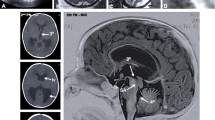Summary
Suckling mice which received a single intraperitoneal injection of 6-aminonicotinamide on the 5th postnatal day, consistently developed hydrocephalus. During the early stages of hydrocephalus (7–9 days after injection), aqueductal lesions were characterized by edematous ependymal and subependymal cells, and spongy changes in the periaqueductal area, which resulted in aqueduct stenosis. Later stages (after 20 days post-injection) showed that these edematous changes totally subsided, leaving an obliterated aqueduct which was similar to that of human congenital hydrocephalus. At the completely obliterated area, ultrastructural investigation disclosed a normal-looking neuropil but no aqueductal lumen. In the remaining ependymal cell, increased intermediate filaments and lipid droplets occurred. These data suggest that acute ependymal cell degeneration during the perinatal period may result in the profile of aqueduct “agenesis” in human congenital hydrocephalus.
Similar content being viewed by others
References
Aikawa H, Suzuki K, Ito N, Iwasaki Y, Nonaka I (1984) 6-amino-nicotinamide-induced hydrocephalus in suckling mice. J Neuropathol Exp Neurol 43:511–521
Aikawa H, Suzuki K (1985) Aqueduct stenosis induced by a single injection of antivitamin. Dev Brain Res 22:284–287
Aikawa H, Suzuki K (1986) Lesions in the skin, intestine and central nervous system induced by an antimetabolite of niacin. Am J Pathol 122:335–342
Borit A, Sidman RL (1972) New mutant mouse with communicating hydrocephalus and secondary aqueductal stenosis. Acta Neuropathol (Berl) 21:316–331
Chamberlain JG (1970) Early neurovascular abnormalities underlying 6-aminonicotinamide (6-AN)-induced congenital hydrocephalus in rats. Teratology 3:377–387
Chui E, Garcia JH (1979) Pathogenesis of 6-aminonicotinamide neurotoxicity: new structural analysis. In: Zimmermann HM (ed) Progress in neuropathology, vol 4. Raven Press, New York, pp 341–359
Duffy PE, Graf L, Huang Y-Y, Rapport MM (1979) Glial fibrillary acidic protein in ependymomas other brain tumors. Distribution, diagnostic criteria, and relation to formation of processes. J Neurol Sci 40:133–146
Friede RL (1975) Hydrocephalus-special pathology. In: Developmental neuropathology. Springer, New York, pp 214–229
Griffiths IR, Kelly PAT, Grome JJ (1981) Glucose utilization in the central nervous system in the acute gliopathy due to 6-aminonicotinamide. Lab Invest 44:547–552
Herken H, Lange K, Kolbe H, Keller K (1974) Antimetabolic action on the pentose phosphate pathways in the central nervous system induced by 6-aminonicotinamide. In: Ganazzani E, Herken H (eds) Central nervous system. Studies on metabolic regulation and function. Springer, New York, pp 41–54
Horita N, Oyanagi S, Ishii T, Izumiyama Y (1978) Ultrastructure of 6-aminonicotinamide (6-AN)-induced lesions in the central nervous system of the rats. I. Chromatolysis and other lesions in the cervical cord. Acta Neuropathol (Berl) 44:111–119
Horita N, Ishii T, Izumiyama Y (1981) Ultrastructure of 6-amino-nicotinamide (6-AN)-induced lesions in the central nervous system of the rats. III. Alterations of the spinal gray matter lesion with aging. Acta Neuropathol (Berl) 53:227–235
Hsu SM, Raine L, Fanger H (1981) Use of avidin-biotinperoxidase complex (ABC) in immunoperoxidase technique: a comparison between ABC and unlabeled antibody (PAP) procedures. J Histochem Cytochem 29:577–580
Johnson RT, Johnson KP (1968) Hydrocephalus following viral infection: the pathology of aqueductal stenosis developing after experimental mumps virus infection. J Neuropathol Exp Neurol 27:591–606
Kalter H (1963) Experimental mammalian teratogenesis. A study of galactoflavin-induced hydrocephalus in mice. J Morphol 112:303–317
Kauffman FC, Johnson EC (1974) Cerebral energy reserves and glycolysis in neural tissue of 6-aminonicotinamide-treated mice. J Neurobiol 5:379–392
Kohn DF, Chinookoswong N, Chou SM (1984) Congenital hydrocephalus. Am J Pathol 114:184–185
Newberne PM, O'Dell DL (1958) Histopathology of hydrocephalus resulting from a deficiency of vit. B12. Proc Soc Exp Biol Med 97:62–65
Ogata J, Hochwald GM, Cravioto H, Ransohoff J (1972) Distribution of intraventricular horseradish peroxidase in normal and hydrocephalic cat brains. J Neuropathol Exp Neurol 31:454–463
O'Sullivan BM, Blakemore WF (1980) Acute nicotinamide deficiency in the pig induced by 6-aminonicotinamide. Vet Patho 17:748–758
Overholster MD, Whitley JR, O'Dell BL, Hogan AG (1954) The ventricular system in hydrocephalic rat brains produced by a deficiency of vitamin B12 or folic acid in the maternal diet. Anat Rec 120:917–933
Raimondi AJ, Clark SJ, McLone DG (1976) Pathogenesis of aqueductal occlusion in congenital murine hydrocephalus. J Neurosurg 45:66–77
Raine CS, Bornstein MB (1974) Unusual profiles in organotypic cultures of central nervous tissue. J Neurocytol 3:313–325
Roessmann U, Velasco ME, Sindely SD, Gambetti P (1980) Glial fibrillary acidic protein (GFAP) in ependymal cells during development. An immunocytochemical study. Brain Res 200:13–21
Russel DS, Rubinstein LJ (1974) Ependymomas. In: Pathology of tumours of the nervous system, 2nd edn. Arnold, London, pp 204–212
Sasaki S (1982) Brain edema and gliopathy induced by 6-amino-nicotinamide intoxication in the central nervous system of rats. Am J Vet Res 43:1691–1695
Schneider H, Cervos-Navarro J (1974) Acute gliopathy in spinal cord and brain stem induced by 6-aminonicotinamide. Acta Neuropathol (Berl) 27:11–23
Schochet SS Jr (1970) Pathogenesis of 6-aminonicotinamide neurotoxicity. VIth International Congress of Neuropathology Proceeding, Masson, Paris, pp 89 [abstr]
Sotelo C, Rio JP (1980) Cerebellar malformation obtained in rats by early postnatal treatment with 6-aminonicotinamide. Role of neuro-glia interactions in cerebellar development. Neuroscience 5:1737–1759
Stempak JG (1964) Etiology of trypan blue-induced antenatal hydrocephalus in the albino rat. Anat Rec 148:561–571
Stempak JG (1965) Etiology of antenatal hydrocephalus induced by folic acid deficiency in the albino rat. Anat Rec 151:287–296
Weller RO, Wisniewski H, Shulman K, Terry RD (1972) Experimental hydrocephalus in young dogs: histological and ultrastructural study of the brain tissue damage. J Neuropathol Exp Neurol 30:613–626
Author information
Authors and Affiliations
Additional information
Supported in part by research grants NS-03356, NS-10803 from NINCDS, USPHS
Rights and permissions
About this article
Cite this article
Aikawa, H., Kobayashi, S. & Suzuki, K. Aqueductal lesions in 6-aminonicotinamide-treated suckling mice. Acta Neuropathol 71, 243–250 (1986). https://doi.org/10.1007/BF00688046
Received:
Accepted:
Issue Date:
DOI: https://doi.org/10.1007/BF00688046




